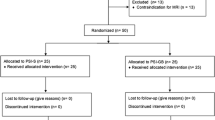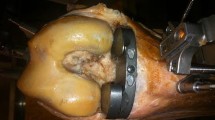Abstract
Purpose
This study aimed to compare the reliability of two gap assessment methods (component and bone surface gap measurement vs. planned gap balance) and identify the contributors to component gaps other than planned gaps.
Methods
The prospectively collected data for 122 consecutive primary total knee arthroplasties (TKAs; 114 patients). After femoral planning for gap balancing, the medial and lateral planned gaps were calculated (planned gap). The established medial extension and flexion gaps (MEG and MFG, respectively) and lateral extension and flexion gaps (LEG and LFG, respectively) were measured with and without the TKA components (bone surface and component gaps) at 0° and 90° flexion. The intraclass and Pearson correlation coefficients for each gap measurement method were assessed using planned gap values, and multiple linear regression analyses were performed to identify the contributors to component gaps.
Results
Compared with the bone surface gap measurement, the component gap measurement showed higher reliability and stronger correlation with the planned gap balance for each gap. The changes in the medial posterior femoral offset contributed to the MEG and LEG, whereas those in the joint line height contributed to the LEG. The changes in the hip–knee–ankle angle and lateral posterior femoral offset contributed to the LFG.
Conclusion
Component gap measurements of the established gap more accurately and reliably reflect the planned gap balance than do bone surface gap measurements. The established gaps are affected by several factors other than femoral planning.




Similar content being viewed by others
Abbreviations
- HKA:
-
Hip–knee–ankle
- ICC:
-
Intraclass correlation coefficient
- JLH:
-
Joint line height
- KSKS:
-
Knee Society Knee Score
- KSFS:
-
Knee Society Function Score
- LEG:
-
Lateral extension gap
- LFG:
-
Lateral flexion gap
- LPFO:
-
Lateral posterior femoral offset
- MCL:
-
Medial collateral ligament
- MEG:
-
Medial extension gap
- MFG:
-
Medial flexion gap
- MPFO:
-
Medial posterior femoral offset
- ROM:
-
Range of motion
- TKA:
-
Total knee arthroplasty
- WOMAC:
-
Western Ontario and McMaster Universities Osteoarthritis index
References
Bae DK, Song SJ (2011) Computer assisted navigation in knee arthroplasty. Clin Orthop Surg 3(4):259–267. https://doi.org/10.4055/cios.2011.3.4.259
Bellamy N, Buchanan WW, Goldsmith CH, Campbell J, Stitt LW (1988) Validation study of WOMAC: a health status instrument for measuring clinically important patient relevant outcomes to antirheumatic drug therapy in patients with osteoarthritis of the hip or knee. J Rheumatol 15(12):1833–1840
Cooke TD, Sled EA, Scudamore RA (2007) Frontal plane knee alignment: a call for standardized measurement. J Rheumatol 34(9):1796–1801
Dorr LD, Boiardo RA (1986) Technical considerations in total knee arthroplasty. Clin Orthop 205:5–11
Fehring TK, Odum S, Griffin WL, Mason JB, Nadaud M (2001) Early failures in total knee arthroplasty. Clin Orthop 392:315–318. https://doi.org/10.1097/00003086-200111000-00041
Gejo R, McGarry MH, Jun BJ, Hofer JK, Kimura T, Lee TQ (2010) Biomechanical effects of patellar positioning on intraoperative knee joint gap measurement in total knee arthroplasty. Clin Biomech (Bristol, Avon) 25(4):352–358. https://doi.org/10.1016/j.clinbiomech.2010.01.005
Gejo R, Morita Y, Matsushita I, Sugimori K, Kimura T (2008) Joint gap changes with patellar tendon strain and patellar position during TKA. Clin Orthop 466(4):946–951. https://doi.org/10.1007/s11999-008-0154-2
Ghosh KM, Merican AM, Iranpour F, Deehan DJ, Amis AA (2009) The effect of overstuffing the patellofemoral joint on the extensor retinaculum of the knee. Knee Surg Sports Traumatol Arthrosc 17(10):1211–1216. https://doi.org/10.1007/s00167-009-0830-0
Griffin FM, Insall JN, Scuderi GR (2000) Accuracy of soft tissue balancing in total knee arthroplasty. J Arthroplast 15(8):970–973. https://doi.org/10.1054/arth.2000.6503
Hirschmann MT, Moser LB, Amsler F, Behrend H, Leclerq V, Hess S (2019) Functional knee phenotypes: a novel classification for phenotyping the coronal lower limb alignment based on the native alignment in young non-osteoarthritic patients. Knee Surg Sports Traumatol Arthrosc 27(5):1394–1402
Hirschmann MT, Moser LB, Amsler F, Behrend H, Leclercq V, Hess S (2019) Phenotyping the knee in young non-osteoarthritic knees shows a wide distribution of femoral and tibial coronal alignment. Knee Surg Sports Traumatol Arthrosc 27(5):1385–1393
Mitsuyasu H, Matsuda S, Fukagawa S, Okazaki K, Tashiro Y, Kawahara S, Nakahara H, Iwamoto Y (2011) Enlarged post-operative posterior condyle tightens extension gap in total knee arthroplasty. J Bone Jt Surg Br 93(9):1210–1216. https://doi.org/10.1302/0301-620x.93b9.25822
Hanada H, Whiteside LA, Steiger J, Dyer P, Naito M (2007) Bone landmarks are more reliable than tensioned gaps in TKA component alignment. Clin Orthop 462:137–142. https://doi.org/10.1097/BLO.0b013e3180dc92e7
Hughston JC, Jacobson KE (1985) Chronic posterolateral rotatory instability of the knee. J Bone Jt Surg Am 67(3):351–359
Insall J, Tria AJ, Scott WN (1979) The total condylar knee prosthesis: the first 5 years. Clin Orthop 145:68–77
Insall JN, Binazzi R, Soudry M, Mestriner LA (1985) Total knee arthroplasty. Clin Orthop 192:13–22
Insall JN, Dorr LD, Scott RD, Scott WN (1989) Rationale of the Knee Society clinical rating system. Clin Orthop 248:13–14
Insall JN, Easley ME (2001) Surgical techniques and instrumentation in total knee arthroplasty. In: Insall JN (ed) Surgery of the knee, 3rd edn. Churchill Livingston, Philadelphia, pp 1553–1557
Kadoya Y, Kobayashi A, Komatsu T, Nakagawa S, Yamano Y (2001) Effects of posterior cruciate ligament resection on the tibiofemoral joint gap. Clin Orthop 391:210–217. https://doi.org/10.1097/00003086-200110000-00023
Kuo AW, Chen DB, Wood J, MacDessi SJ (2020) Modern total knee arthroplasty designs do not reliably replicate anterior femoral morphology. Knee Surg Sports Traumatol Arthrosc 28(9):2808–2015. https://doi.org/10.1007/s00167-019-05610-3
Lee S-Y, Lim H-C, Jang K-M, Bae J-H (2017) What factors are associated with femoral component internal rotation in TKA using the gap balancing technique? Clin Orthop 475(8):1999–2010. https://doi.org/10.1007/s11999-017-5319-4
Matsumoto T, Kuroda R, Kubo S, Muratsu H, Mizuno K, Kurosaka M (2009) The intra-operative joint gap in cruciate-retaining compared with posterior-stabilised total knee replacement. J Bone Jt Surg Br 91(4):475–480. https://doi.org/10.1302/0301-620X.91B4.21862
Matsumoto T, Muratsu H, Tsumura N, Mizuno K, Kuroda R, Yoshiya S, Kurosaka M (2006) Joint gap kinematics in posterior-stabilized total knee arthroplasty measured by a new tensor with the navigation system. J Biomech Eng 128(6):867–871. https://doi.org/10.1115/1.2354201
Matsumoto T, Muratsu H, Tsumura N, Mizuno K, Kurosaka M, Kuroda R (2009) Soft tissue balance measurement in posterior-stabilized total knee arthroplasty with a navigation system. J Arthroplast 24(3):358–364. https://doi.org/10.1016/j.arth.2008.01.001
Mihalko WM, Saleh KJ, Krackow KA, Whiteside LA (2009) Soft tissue balancing during total knee arthroplasty in the varus knee. J Am Acad Orthop Surg 17(12):766–774. https://doi.org/10.5435/00124635-200912000-00005
Mihalko WM, Whiteside LA, Krackow KA (2003) Comparison of ligament-balancing techniques during total knee arthroplasty. J Bone Joint Surg Am 85-A(Suppl 4):132–135. https://doi.org/https://doi.org/10.2106/00004623-200300004-00018
Morris BA, D’Lima DD, Slamin J, Kovacevic N, Arms SW, Townsend CP, Colwell Jr CW (2001) e-Knee: evolution of the electronic knee prosthesis. Telemetry technology development. J Bone Joint Surg Am 83-A(Suppl 2):62–66. https://doi.org/https://doi.org/10.2106/00004623-200100021-00013
Noyes FR, Barber-Westin SD, Hewett TE (2000) High tibial osteotomy and ligament reconstruction for varus angulated anterior cruciate ligament-deficient knees. Am J Sports Med 28(3):282–296. https://doi.org/10.1177/03635465000280030201
Okamoto Y, Nakajima M, Jotoku T, Otsuki S, Neo M (2016) Capsular release around the intercondylar notch increases the extension gap in posterior-stabilized rotating-platform total knee arthroplasty. Knee 23(4):730–735. https://doi.org/10.1016/j.knee.2015.11.022
Pierson JL, Ritter MA, Keating EM, Faris PM, Meding JB, Berend ME, Davis KE (2007) The effect of stuffing the patellofemoral compartment on the outcome of total knee arthroplasty. J Bone Jt Surg Am 89(10):2195–2203. https://doi.org/10.2106/JBJS.E.01223
Rhee SJ, Seo CH, Suh JT (2013) Navigation-assisted total knee arthroplasty for patients with extra-articular deformity. Knee Surg Relat Res 25(4):194–201. https://doi.org/10.5792/ksrr.2013.25.4.194
Rosa JM, Oliveira M, Vide J, Carvalho MM, Duarte A, Cruz HAd, Fontes AP, Sousa JP (2019) The role of the femoral anterior offset index on the degree of flexion in total knee arthroplasty. Int J Res Orthop 5(3):376–381. https://doi.org/https://doi.org/10.18203/issn.2455-4510.IntJResOrthop20191780
Sharkey PF, Hozack WJ, Rothman RH, Shastri S, Jacoby SM (2002) Insall Award paper. Why are total knee arthroplasties failing today? Clin Orthop 404:7–13. https://doi.org/10.1097/00003086-200211000-00003
Unitt L, Sambatakakis A, Johnstone D, Briggs TW, Balancer Study G (2008) Short-term outcome in total knee replacement after soft tissue release and balancing. J Bone Jt Surg Br 90(2):159–165. https://doi.org/10.1302/0301-620X.90B2.19327
Wallace AL, Harris ML, Walsh WR, Bruce WJ (1998) Intraoperative assessment of tibiofemoral contact stresses in total knee arthroplasty. J Arthroplasty 13(8):923–927. https://doi.org/10.1016/s0883-5403(98)90200-5
Winemaker MJ (2002) Perfect balance in total knee arthroplasty: the elusive compromise. J Arthroplast 17(1):2–10. https://doi.org/10.1054/arth.2002.29321
Funding
This research did not receive any specific grant from funding agencies in the public, commercial, or not-for-profit sectors.
Author information
Authors and Affiliations
Contributions
Conception and design: SB Han and KH Shin; data collection: KH Shin and KM Jang; analysis and interpretation: KH Shin; writing the article: KH Shin; critical revision of the article for intellectual content: SB Han and KH Shin; final approval of the article: SB Han; statistical analysis: KH Shin; obtained funding: not applicable; overall responsibility: KH Shin, KM Jang and SB Han.
Corresponding author
Ethics declarations
Conflict of interest
All authors declare no conflict of interest regarding the preparation of the manuscript. No funding source is applicable to any part of this study.
Ethical approval
This study was approved by the institutional review board of Anam Hospital of Korea University Medical Center.
Additional information
Publisher's Note
Springer Nature remains neutral with regard to jurisdictional claims in published maps and institutional affiliations.
Rights and permissions
About this article
Cite this article
Shin, KH., Jang, KM. & Han, SB. Component gap measurement reflects the planned gap balance during total knee arthroplasty more accurately and reliably than bone surface gap measurement. Knee Surg Sports Traumatol Arthrosc 30, 584–592 (2022). https://doi.org/10.1007/s00167-020-06324-7
Received:
Accepted:
Published:
Issue Date:
DOI: https://doi.org/10.1007/s00167-020-06324-7




